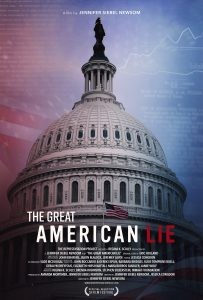
The Great American Lie 2019
Distributed by The Representation Project
Produced by Amanda Mortimer, Brenda Robinson, Regina K. Scully, Jennifer Siebel Newsom, and Stephen M. Silberstein
Directed by Jennifer Siebel Newsom
Streaming, 99 mins
College - General Adult
Economics; Labor; Social Movements
Date Entered: 09/02/2020
Reviewed by Sam Buechler, Student Success Librarian, Washington State University VancouverThe Great American Lie aims to interrogate the various intersections of “societal and economic immobility” within America. Throughout, the film provides a decent introduction to the ways that societal and historical influence have contributed to the devaluation of “feminine professions” (e.g. teaching), wealth disparities, the prison industrial complex, and racial inequality. Each of these concepts are positioned under the themes of empathy and community meant to inspire action, however these themes ultimately leave the film feeling contradictory, expansive, and watered down.
There is something to be said for the things this film does well: there’s a diverse panel of experts, exploration of lived experiences, and a crafted balance of statistics and rhetoric. Many of the lived experiences are thoughtful testaments to the realities of immobility within American society and ultimately provide the greatest impact in the film. We hear from a principal and her students who retell their experiences with ICE raids, protesters detail instances of assault in the restaurant industry, and a mother describes her anger at a system that imprisoned her daughter and asked her to pay the price. These are strong, powerful stories which unfortunately are lessened in impact by the film’s conclusion. As the score crescendos, we hear the story of a white, Midwestern woman and her “come to God” moment which allowed her to find empathy for (some) individuals she previously held in contempt. We hear stories of great injustice and we learn of actions being taken to combat them but in the end, we’re meant to walk away with the story of a white woman who found her own way to empathy.
To drive home this woman’s story, the final shot of the film is of a sprawling suburb with blue skies and text that reads, “When we see the humanity in each other and we value empathy, care, and community, we safeguard equality… and the American dream.” This quote is, what I would deem, an affirmation disguised as a call to action and its benevolence contrasts harshly with the work of the activists we hear from throughout. It’s clear that this film isn’t meant to reveal harsh realities or inform on how to enact change, instead it seeks to make you feel hopeful, to reflect common values as revolutionary, and to maybe teach some introductory concepts along the way. It is a film meant for the Midwestern white woman who feels that the people using food stamps are harming society instead of seeing the structures that force someone to use food stamps as the real harm.
Ultimately, the film included an introduction to several concepts relevant to social and economic justice and it would be a moderately worthwhile watch for an introductory college course encountering these themes for the first time. Regardless, it should be accompanied with critical discussion on what the film leaves out, whose voices are actually centered, and the consequences of empty intent. Thus, this film is recommended with reservations.